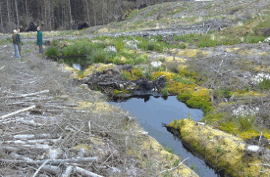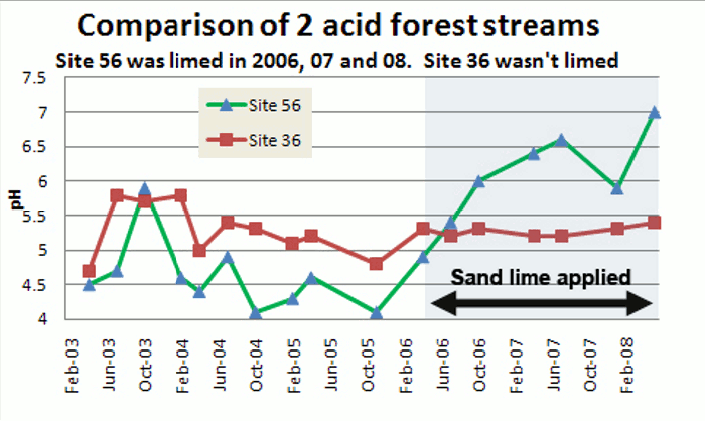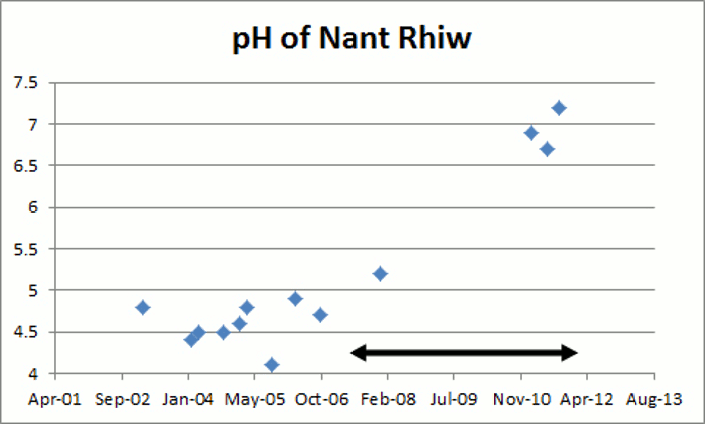Restoration of Hydrological source areas and correction of acid waters
In April 2010 Stephen Marsh-Smith and Simon Evans visited the blanket bog restoration LIFE + project in North Wales (LIFE06 NAT/UK/000134). This project had determined the most effective techniques for the restoration of hydrological function of drained peat lands. In May 2011 they published some very encouraging results which indicate what we could expect from this project's actions in terms of normalised flows and reduced sediment budgets. We have adapted their methodology for a forestry situation (available upon request)

Within the public forest contracts have been issued by FC (following tendering within their pool of approved contractors). WUF staff are to be present whenever drain blocking operations are taking place to ensure that the project's aims are delivered.
In the first half of 2011 mature coniferous forest was harvested from the sources Tawr 1,2,3,4 and 5 as part of the overall forest plan. In September 2011 the project funded premature tree removal from Twlc 4.
Drain blocking commenced on the unforested Twlc 1 and Twlc 2 in September 2011 and will complete the remaining Twlc sources and Tawr 1,2,3,4 and 5 the next time there is an extended dry period.
The privately owned sources will be cleared of trees during in 2012 and the drainage restored in 2013.
The baseline survey of the acid monitoring found a clear signature of the previous source and sand liming conducted within the pHISH project. Importantly, pH appeared to be proportional to the amount of sand line applied against discharge of the stream.
The project has expanded the sand liming operations developed in the pHish project as a short term solution whilst we wait for the HSAs to be restored. The results have been very encouraging.
During our pHish project (ERDF 2002-2008) we relied on research done by Ormerod et al which showed that best long term effect improvement on water quality and increased pH on first order streams was achieved by liming the hydrological sources of each stream with a substantial dose of powdered lime (<40tonne/Ha) when compared to total forest removal and whole catchment liming.
It was therefore necessary to find a number of these hydrological sources around the catchment in order to achieve the necessary titration to act against acid flushes in particular. In afforested sites, we found that there was an insufficiency of sources to achieve the desired improvements. In 1998, (North American journal of Fisheries management 18: 347-360 Clayton, Dannaway et al) published a comprehensive study on the beneficial effect of introducing sand sized lime directly to small streams.
In 2006, this was tried in the pHish project in a part of the catchment where we had failed to achieve the required dosage by source liming. Initially, the trial stream (draining dense forestry), showed severe flushes to pHs of 4.0 prior to treatment. Treatment with sand liming raised this to a pH mean of 6.5.

The technique was extended to other sites where source liming was not practical including the Nant Rhiw within the Irfon forest. Unfortunately the cessation of monitoring at the end of the pHish project, meant that the efficacy on a catchment scale was not monitored. However, the December 2010 survey conducted within this project changed this, confirming the effect on the Nant Rhiw as being identical to that at site 56 on the Upper Wye and promoted the wider use of sand liming within this project.

The technique simply involves depositing an annual dose of approximately 1.5 to 3 tonnes of limestone particles into a first or second order stream. The particles become progressively integrated with the substrate and provide real protection from acid flushes to fish eggs and invertebrates. Diatom and water quality analysis shows the effects to be enduring for at least two years. Other advantages of sand liming is that important wetlands and peat are not damaged, reducing potential emissions of CO2 and NH4. Also, as atmospheric depositions of H+ reduce, doses can be adjusted accordingly. It is the conjunctive use of both methods that provide the best results.
